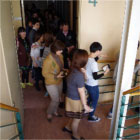According to the Regional Seismic Hazard Measurement Survey announced by the Tokyo Metropolitan Government on September 17, 2013, the level of earthquake risk in the Nampeidai area (Shibuya, Tokyo) where the school is located was as follows: degree 1 for each of the categories of collapse of building, fire, difficulty of evacuation & rescue and also degree 1 for the overall comprehensive risk. (on a five-point scale in which degree 1 indicates the lowest risk.)
The Naganuma campus is considered to be on solid (non-aqueous) ground as evident from the fact that data center facilities that require safe location are also located in the same locale,. This area is designated as “Remaining Area within the District” which indicates that the district’s high safety level eliminates the need to evacuate to other districts. All the three school buildings have been constructed as earthquake-proof, but if needed, evacuation to the park next to the school offers an alternative safety site.
The school buildings have quake-resistant structure. The East Japan Earthquake which recorded level upper 5 (JMA Seismic Intensity) caused no damage to any of the school buildings, facilities or equipment. The School has continued to function in excellent condition.
The school is equipped with emergency power generators which are able to secure the minimum electricity required in the rare event of a blackout. Likewise, the School continually maintains emergency stockpiles of such supplies as food, water, breathing masks and medical goods.

It is difficult to predict natural hazards in advance. What is important is that we can quickly and calmly evacuate to safety, dealing with any difficult situation that may arise. It’s good to be prepared in our daily school life for any possible disasters.
Our school conducts an emergency drill once every six months to raise students' awareness regarding emergency evacuations.